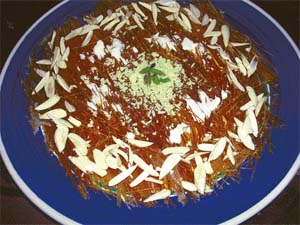|
Food Talk
Divine dessert
These are served in a
myriad ways substituting for rice and it is not uncommon in the South to
fashion an upama with sevian, writes Pushpesh
Pant
 SOME
say that it was the prince amongst travellers, Marco Polo, the Italian,
who brought them to India on his way back from China while others
contest this and claim that it was native genius that invented sevian
that the world knows as vermicelli. The firang name is obviously
inspired by their resemblance to — unmentionable at dinner time —
worms! SOME
say that it was the prince amongst travellers, Marco Polo, the Italian,
who brought them to India on his way back from China while others
contest this and claim that it was native genius that invented sevian
that the world knows as vermicelli. The firang name is obviously
inspired by their resemblance to — unmentionable at dinner time —
worms!
These are served in myriad
ways—most commonly, as kheer/payasam substituting for
rice and it is not uncommon in South to fashion an upama with sevian.
It was Farouk Miyan from Lucknow who treated us to a savoury chulav
– a recognisable cousin to pulav. At the time of meethi Eid.
the sevian come into their own.
|
Sookhi
Sevian
Ingredients
Sevian (of the very
fine variety, pre- roasted commonly available in the old city in
Delhi. Most stores elsewhere also stock these. Can’t be
substituted with any other kind, however attractively packaged)
500gm
Khoya (grated) 200
gm
Ghee/unsalted butter
100 gm Sugar 1cup
Water 2 cups
Cloves 3-4
Green cardamom
(seeds only coarsely
pounded) 4-6
Raisins 50 gm
Pistachios
(slivered) 25 gm
Almonds (slivered)
25 gm
A few strands of
saffron (soaked in 1/8 cup warm milk and crushed with the back of
a spoon)
Method
Put ghee in a
thick-bottomed pan and when hot put the cloves in. As the cloves
change colour and swell add sugar and water, bring to boil. Reduce
the heat to medium low and put the raisins, crushed/ pounded
cardamoms, resins, and the sevian broken into one third their
original size. Stir very gently and simmer till they soak in all
the liquid. Now sprinkle the saffron with the milk.
Remove the pan from
the flame and very gently spread out the strands of sevian with a
fork to ensure that these do not glue together in a gooey mess.
Drizzle the khoya evenly. Garnish with slivers of almond and
pistachio.
You may enrich the
dish with cashewnuts added while cooking and some like a touch of chironji
and a few drops of rose water and a drape of chandi ka vark.
We are quite content to have our fill of this unadorned beauty.
Grated coconut,
though, can provoke us to assault as this seems like adding insult
to injury. Forget the diet, make do with small spoonfuls, but don’t
try to stretch the divine dessert or deny yourself the sinful
delight occasionally.
|
What has always intrigued
us is the dryness that is retained in sookhi sevian even after
these have been cooked well. Whenever we have been tempted to stray from
the familiar straight and narrow path of kheeri we have ended up
looking foolish with burnt strands of once elegant
pasta — simply
inedible.
A cunning chef once told
us that the trick was to use equal measures of sugar, ghee and sevian.
It was not long before it dawned on us that he did not wish to part with
a trade secret.
Whenever we have enjoyed
this delicacy — at Wahid Bhai’s house in Noida — saved, packed and
transported for us all the way from Gorakhpur or sent as a surprise by
Rashmiji, a Kashmiri thespian and exceptional culinary artiste, it has
strengthened our resolve to master the recipe. We are glad to report
that our scheming has succeeded at long last.
Scholarly colleague at the
JNU Gulshan Deitel generously shared her ‘house’ recipe that
demystifies this noble dessert. Poor Marco did not know what he missed
out in China and his compatriots continue to glorify tiramissu!
Go ahead and celebrate any time any place
— almost.
|